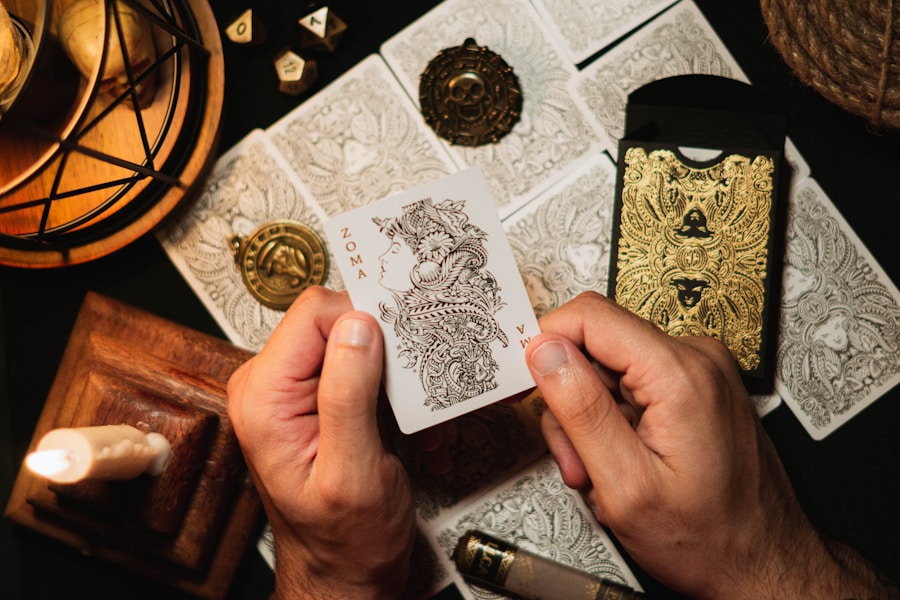
Misinterpretation of tarot cards is a common pitfall for both novice and seasoned readers alike. The imagery and symbolism embedded in each card can be rich and multifaceted, leading to various interpretations depending on the context of the reading and the question posed. For instance, the Tower card, often associated with chaos and upheaval, can be perceived as a harbinger of doom.
However, a deeper understanding reveals that it can also signify necessary change or liberation from outdated structures. This duality can lead to confusion, especially for those who may not have fully grasped the nuances of tarot symbolism. Moreover, the emotional state of the reader can significantly influence how they interpret the cards.
A reader who is feeling anxious or negative may project their feelings onto the cards, interpreting them in a way that aligns with their current mindset rather than the broader meanings.
It is essential for readers to approach each session with an open mind and a willingness to explore multiple layers of meaning, rather than settling for a surface-level interpretation that may not serve the querent’s needs.
Key Takeaways
- Misinterpreting the Cards: Be mindful of projecting personal biases onto the cards and consider multiple interpretations.
- Relying too heavily on the guidebook: Use the guidebook as a reference, but also trust your intuition and personal connection to the cards.
- Using the tarot as a fortune-telling tool: Remember that the tarot is a tool for self-reflection and personal growth, not a tool for predicting the future.
- Neglecting to establish a clear intention: Set a clear intention for your tarot reading to guide the focus and direction of the reading.
- Neglecting self-reflection and intuition: Take time to reflect on the messages of the cards and trust your intuition in interpreting them.
- Failing to create a sacred space for tarot readings: Create a sacred and peaceful environment for your tarot readings to enhance the connection with the cards and your intuition.
Relying too heavily on the guidebook
While guidebooks can be invaluable resources for understanding tarot cards, an overreliance on them can stifle a reader’s intuitive abilities. Many beginners turn to these texts for definitive meanings, often memorizing interpretations without allowing their personal insights to emerge. This can create a rigid framework that limits the reader’s ability to connect with the cards on a deeper level.
For example, if a reader encounters the Empress card and immediately refers to the guidebook, they might miss out on their own intuitive associations with fertility, creativity, or nurturing that could provide richer insights into the querent’s situation. Additionally, guidebooks often present meanings in a one-size-fits-all manner, which may not resonate with every individual or context. Each reading is unique, influenced by the querent’s personal experiences and the specific question at hand.
By relying too heavily on a guidebook, readers may overlook the subtleties that arise from their own intuition or the dynamic interplay between the cards in a spread. This can lead to readings that feel generic or disconnected from the querent’s reality, ultimately diminishing the effectiveness of the tarot as a tool for guidance and self-discovery.
Using the tarot as a fortune-telling tool

The perception of tarot as merely a fortune-telling tool is a misconception that can limit its potential as a means of self-exploration and personal growth. While many people approach tarot with the hope of predicting future events, this perspective often overlooks the cards’ capacity to illuminate underlying issues and facilitate introspection. For instance, drawing cards about future outcomes may provide some insight; however, it is essential to recognize that these outcomes are not set in stone.
Neglecting to establish a clear intention
Establishing a clear intention before conducting a tarot reading is crucial for obtaining meaningful insights. Without a focused question or purpose, readings can become muddled and lack direction. A vague inquiry such as “What does my future hold?” may yield ambiguous results that fail to address specific concerns or desires.
In contrast, a well-defined intention—such as “What steps can I take to improve my career satisfaction?”—can guide the reading and facilitate more relevant interpretations of the cards drawn. Moreover, intentions serve as a framework for both the reader and querent, creating a shared understanding of what is being explored during the session. This clarity allows for deeper engagement with the cards and encourages both parties to reflect on their thoughts and feelings related to the question at hand.
When readers neglect to establish an intention, they risk losing sight of the purpose behind their inquiry, which can lead to superficial readings that do not resonate with the querent’s true needs.
Neglecting self-reflection and intuition
Self-reflection and intuition are integral components of effective tarot reading that are often overlooked. Many readers focus solely on card meanings or external interpretations without taking time to consider their own thoughts and feelings about the reading. This neglect can result in readings that lack depth and personal relevance.
For example, when interpreting the Five of Cups—a card symbolizing loss and grief—a reader who does not engage in self-reflection may miss an opportunity to connect with their own experiences of loss, which could enrich their understanding of the card’s message. Intuition plays an equally vital role in tarot readings. Each card carries layers of meaning that can resonate differently depending on the reader’s personal experiences and insights.
By tuning into their intuition, readers can access deeper interpretations that go beyond textbook definitions. This intuitive connection allows for a more dynamic interaction with the cards, enabling readers to draw upon their unique perspectives and experiences to provide tailored guidance for querents. Neglecting these aspects diminishes the richness of tarot readings and limits their potential for fostering personal growth.
Failing to create a sacred space for tarot readings

Creating a sacred space for tarot readings is essential for fostering an environment conducive to introspection and connection with the cards. A designated area that feels safe and inviting allows both the reader and querent to engage more fully in the experience. This space can be enhanced through various practices such as lighting candles, burning incense, or playing soft music—elements that help set an intentional atmosphere for reflection and exploration.
When readers neglect this aspect, they may find it challenging to enter a focused mindset or establish a meaningful connection with the cards. Additionally, a sacred space serves as a physical reminder of the importance of ritual in tarot practice. Rituals help ground readers in their intentions and create a sense of reverence for the process.
By taking time to prepare their environment—whether through cleansing rituals or arranging cards thoughtfully—readers signal to themselves and their querents that this is a special moment worthy of attention and care. Failing to create such an environment can lead to distractions or disconnection during readings, ultimately undermining the potential insights that could arise from a more intentional approach.
If you are interested in learning more about tarot cards and their meanings, you may also want to check out this article on The Tarot Card Fool: Embracing New Beginnings and the Unknown. This article delves into the symbolism and significance of the Fool card in tarot readings, offering insights into embracing change and taking risks. It can be a valuable resource for beginners looking to deepen their understanding of tarot.
FAQs
What are some common mistakes to avoid when starting to learn tarot?
Some common mistakes to avoid when starting to learn tarot include relying too heavily on memorized meanings, not trusting your intuition, and using tarot as a definitive answer rather than a tool for guidance.
Is it important to have a clear intention when doing a tarot reading?
Yes, having a clear intention when doing a tarot reading is important as it helps to focus the energy and purpose of the reading. It can also help to provide more accurate and relevant insights.
Should beginners rely solely on tarot guidebooks for interpretations?
While tarot guidebooks can be helpful for beginners, it’s important not to rely solely on them for interpretations. It’s also important to trust your intuition and personal connection to the cards when interpreting their meanings.
Can tarot readings predict the future?
Tarot readings are not meant to predict the future with absolute certainty. Instead, they provide guidance and insight into the present moment and potential future outcomes based on current energies and choices.
Is it necessary to cleanse and charge tarot cards?
Many practitioners believe it is necessary to cleanse and charge tarot cards to clear them of any previous energies and to infuse them with your own intentions and energy. This can be done through various methods such as smudging, moonlight, or intention setting.






